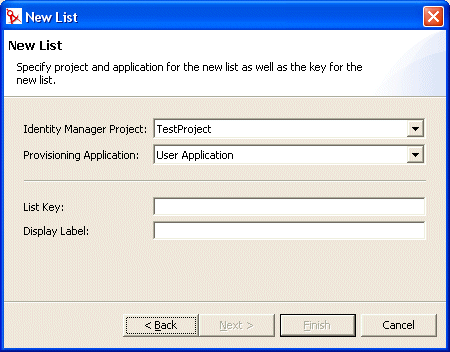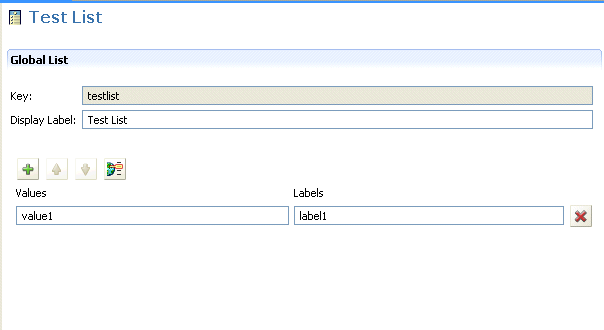3.3 Working with Lists
The lists node lets you define the contents of global lists. Global lists are used by the Identity Manager user application to:
-
Provide a list of values for an attribute. When the attribute is displayed for editing in the user interface, the possible values are displayed as a drop-down list.
-
Define the list, for details, see Section 3.3.1, About the Preferred Locale List.
-
Define the categories available to the Provisioning Request Configuration plug-in to iManager. This is a special list. For details, see Section 3.3.2, About the Provisioning Category List.
To create a new global list:
-
Launch the New List Wizard in one of these ways:
From Designer’s menus:
-
Select , then choose , then click
When launched from the File menu, the dialog box contains fields not displayed when launched in other ways.
-
Select .
From the provisioning view:
-
Select the Lists node, right-click and choose .
From the directory abstraction layer editor:
-
Click
-
Select the Lists node, right-click and choose
The New List dialog box displays.

-
-
Fill in the fields as follows:
Field
Description
Select the Identity Manager project and provisioning application where you want to add the list.
NOTE:These fields display when you launch the wizard from the menu.
The unique identifier for the list.
The string used when the list is displayed in the user application. You can localize this label. For more information, see Section 3.6, Localizing Display Text.
-
Click The Global Lists property page displays for editing.

-
Fill in the fields as follows:
The following table describes the wizard’s buttons:
Button
Description

Adds a new Value


Moves the row up or down in the list. This order specifies how the labels are displayed in the user application at runtime.

Displays the localization dialog box. For more information on using the dialog box, see Section 3.6.2, Localizing Text.

Deletes the row.
-
Save the project.
-
Deploy the list to make it available in the runtime environment.
3.3.1 About the Preferred Locale List
The list represents the default language for the user application when the browser language is not a supported language. The user application’s default configuration of the action displays the list.
3.3.2 About the Provisioning Category List
The list defines the set of categories that help you organize provisioned resources (entitlements) and provisioning requests. The categories in this list display in:
-
Designer—Provisioning request definition editor plug-in
-
iManager—Provisioning Request Configuration plug-in
-
user application— tab
You cannot change the list key, but you can add more items to the list or change the existing category values and labels.
To modify the contents of the :
-
Choose the Lists node.
-
Select .
-
Use the global list property pane to make your modifications.
NOTE:The field is used to populate the category key. The field restricts you to letters, numbers, and underscore (_)characters because these are the valid characters in the category key (which is used internally as an identifier for the category).
-
Save, then deploy your changes. Remember to update the application server’s cache.
After your changes are deployed, they are reflected in the user application and the iManager plug-in. They are reflected in Designer when saved.